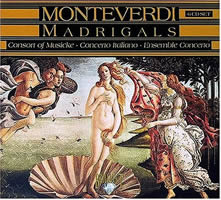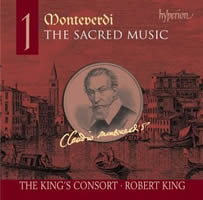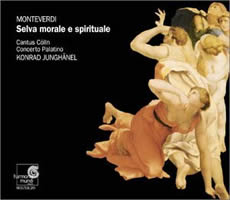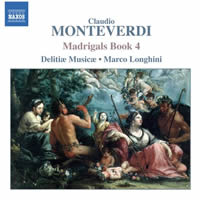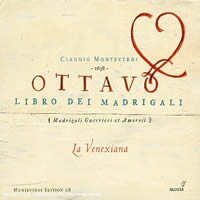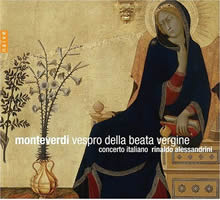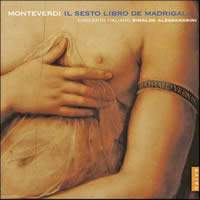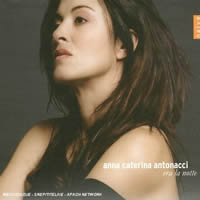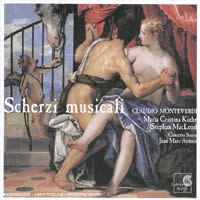Italian Vacation 4. (con Claudio)
|
Grant Chu Covell [May 2006.] Monteverdi recordings exist for every taste. Do you prefer women’s voices in the madrigals, doubled parts and / or an editor’s added instrumental accompaniment? Perhaps you think only native speakers can properly sing Italian? I know what pleases me: a small well-blended chorus, gently tapered phrases and notes (mannered, yes, but lines do emerge in greater relief), frisky tempos and slightly resonant recordings. Most of today’s “enlightened” productions meet these requirements. I am partial to Italians singing in their native tongue. Certainly, Monteverdi’s compatriots naturally respond to the text’s nuances, sensual or sacred. Now you’ll know whether to discount my remarks should I stomp upon (or completely omit) your preferred performer or style. (Years in parenthesis are publication dates.)
A favorite madrigal is the unusually scored canzonetta for two violins and sopranos, Chiome d’oro from Book VII (1619). Perhaps unfairly, this madrigal can determine how I judge an entire package. My preferred recording is the 1989 Tactus TC 56031103/4 with Ensemble “Concerto” and Cappella Mauriziana under Roberto Gini. Positioned as the 11th item on the second disc, this madrigal is a burst of heavenly sunshine. Cristina Miatello, Cettina Cadelo, Carlo De Martini and Enrico Onofri revel coquettishly in the unusual scoring. Chiome d’oro may be more familiar as the foundation for Beatus vir Primo from the 1640/41 Selva Morale e Spirituale. Robert King’s four-disc traversal of Monteverdi’s sacred music places this on “The Sacred Music – 1,” Hyperion CDA67428, and frankly doesn’t disabuse me of the notion that Brits can’t do Monteverdi. I vastly prefer a 3-CD set with Cantus Cölln and Concerto Palatino under Konrad Junghänel, Harmonia Mundi HMC901718.20. Brilliant Classics reissued Tactus’ Settimo Libro pair in a six-disc assortment (99710) alongside other Tactus material filling three more discs: bits from Book VIII, the 1632 Scherzi Musicali, Lamento d’Arianna, Lamento d’Ottavia, and madrigals from Books I–IV with Tasso texts. A sixth disc reissues The Consort of Musicke in 15 “Madrigale Erotici e Spirituali,” earthy madrigals with matching contrafacta (same tune, sacred text) which can also be had on DVD with interspersed commentary and singers in costume (Brilliant Classics 99931). Unlike other Brilliant boxed reissues which come in sleeves, here each CD has its own jewel case. The booklets contain only Italian texts, no translations, no notes. Brilliant’s cover art, Botticelli’s “Birth of Venus” predating the music by more than 150 years, suggests they’re going after fad-influenced impulse buyers with this bulky, impractical set.
Claudio MONTEVERDI: Il Quarto Libro de’ Madrigali (1603). Delitiae Musicae: Alessandro Carmignani, Paolo Costa (counterten.), Fabio Förnari, Paolo Fanciullacci (ten.), Marco Scavazza (bar.), Walter Testolin (bass), Maurizio Piantelli (theorbo), Carmen Leoni (cemb.), Marco Longhini (cond.). Naxos 8.555310 (http://www.naxos.com/). Claudio MONTEVERDI: Ottavo Libro dei Madrigali, “Madrigali Guerrieri et Amorosi” (1638). La Venexiana: Emanuela Galli, Alena Dantcheva, Nadia Ragni, Roberta Mameli (sop.), Kiersti Odegaard (mez. sop.), Claudio Cavina (counterten. and cond.), Giuseppe Maletto, Sandro Naglia, Giovanni Cantarini, Mario Cecchetti (ten.), Daniele Carnovich, Matteo Bellotto (bass). Glossa GCD 920928 (3 CDs) (http://www.glossamusic.com/). Monteverdi Edition 08. Distributed in the US by Qualiton (http://www.qualiton.com/). Working towards a complete madrigal series, Glossa recently released Book VIII, and Naxos, Book IV. Presented in attractive digipaks (consistent with their website’s aesthetic), Glossa’s Monteverdi has been issued somewhat randomly whereas Naxos has been progressing in a more orderly fashion. A thumbnail comparison of both series’ Secondo Libro dei Madrigali (1590) highlights differences: La Venexiana (Glossa GCD 920922) performs a cappella one-voice-per-part drawing from a tight ensemble of six mixed voices whereas Delitiae Musicae (Naxos 8.555308) adds supporting continuo to a six-person all-male ensemble. Delitiae Musicae features two countertenors; La Venexiana, one. Several of the Glossa singers have recorded this material before. The occasional lute and supporting instruments add variety to Delitiae Musicae’s voices. In his well-considered Naxos notes, Longhini discusses the likelihood that male choruses would have been historically possible. Delitiae Musicae’s director also explains why Monteverdi’s new style provoked such controversy. Take it or leave it, I’ve generally thought that what Monteverdi did for the madrigal corresponds to Mahler’s contributions to the symphony. Spread across the sound field, Delitiae Musicae’s men sing with a charming, unhurried leisureliness. Their smooth and balanced sound beguiles. Theorbo and / or cembalo discreetly support half the songs. Within Book IV, Luci serene e chiare illustrates the ensemble’s fine intonation where long-held vowels match the clear articulation of rapid passages. The Chiesa di San Pietro in Vincoli (Verona, Italy) proves a superbly resonant recording venue. Longhini’s notes reveal that Book V is already in the can (Naxos 8.555311). I’m eager to hear what happens when continuo becomes obbligato and the drama grows more explicit. Spanning three CDs (70:00 + 50:03 + 73:24), Cavina adds the specified instruments to Book VIII (I note one string player, Giorgio Sanvito, from 1999’s Tactus TC 561306 which collected only the madrigali amorosi). The tiny Sinfonia and the following Altri canti d’Amor effectively demonstrate La Venexiana’s poise. Today’s single-voice-per-part and casual tempos have come a long way from the thick textures, romantic exaggerations and souped-up choruses of Leppard’s 1971 selective “Madrigali Guerrieri et Amorosi” (Phillips 432 503-2). La Venexiana’s continuo (harp, theorbo, harpsichord) never overwhelm. Strings in the Ballo delle Ingrate’s entrata play in a stately fashion. In earlier Glossa releases, the sopranos were slightly quivery. Here they do better. Male voices unite extremely well in Gira il nemico insidioso and Perché, t’en fuggi, o Fillide.
Claudio MONTEVERDI: Vespro della beata Vergine da Concerto (1610, ed. Rinaldo Alessandrini). Concerto Italiano, Rinaldo Alessandrini (cond.). Naïve OP 30403 (http://www.naiveclassique.com/). Distributed in the US by Naxos (http://www.naxos.com/). Claudio MONTEVERDI: Il Sesto Libro de Madrigali (1614). Concerto Italiano: Monica Piccinini, Anna Simboli (sop.), Gabriella Martellacci (alt.), Raffaele Giordani, Luca Dordolo, Gianluca Ferrarini (ten.), Sergio Foresti (bass), Loredana Gintoli (harp), Ugo Di Giovanni, Craig Marchitelli (theorbo), Rinaldo Alessandrini (cembalo and cond.). Naïve OP 30423 (http://www.naiveclassique.com/). Distributed in the US by Naxos (http://www.naxos.com/). Not so many years ago, mentioning Monteverdi conjured images of courtiers in flowing Renaissance dress parading happily, singing all the while, blithely ignoring famine, plague and war. The 1610 Vespers’ bold opening, with antiphonal brass (Domine ad adjuvandum me festina, adapted from L’Orfeo’s introduction), achieved a cult following long before the advent of historically informed practice. We know that publication did not always align with actual performance practice, as in Monteverdi’s Selva Morale (1640/41) which was meant to be an anthology, not as works performed in toto. Alessandrini’s notes, summarizing current musicological thinking, explain why he adheres to the traditional printed order but cuts the antiphons. Some selections (Lauda Jerusalem and the Magnificat a 7) are taken in different keys, which understandably affect sonorities. The recording was made in Rome’s Palazzo Farnese, France’s embassy since 1874. In pointed remarks, Alessandrini compares that country’s boundless hospitality to his own. With single voices on each part, vocal as well as instrumental, there’s little room for operatic pageantry. The ensemble blending and balance are exquisite, from the echoes in Audi coelum to the agile 10-part Nisi Dominus. The women employ minimal vibrato, top lines floating serenely, especially evident in the Magnificat a 6 and Anna Simboli’s solos for Sonata sopra Sancta Maria, whose instrumental accompaniment continually builds without losing its lilt. If you grew up on stodgy big-boned productions, you are bound to be impressed with Alessandrini’s revelatory clarity. Alessandrini’s madrigal sequence has been slow in coming. Book IV was recorded in 1994, and Books II, V and parts of VIII have appeared sporadically since. For this recording Alessandrini used a 1620 edition in which Monteverdi added continuo, here understated theorbos, harp and / or cembalo. Unlike Delitiae Musicae or La Venexiana, there are no countertenors to bridge women and men’s timbres. Consequently the Concerto Italiano’s blend rings somewhat coarsely, especially in the five-voice Lamento d’Arianna, though the sexes’ delineation is put to good effect in Una donna fra l’altre with its lively back-and-forth. Compared to Longhini or Cavina, Alessandrini’s rein is less rigid, but as this madrigal collection is held to be the most autobiographical, the fluid response to Monteverdi’s emotions seems appropriate.
“Era la notte.” Claudio MONTEVERDI: Lamento d’Arianna (1623); Barbara STROZZI: Lamento: Lagrime mie, a che vi trattenete (1659); Pietro Antonio GIRAMO: Lamento della pazza: Chi non mi conosce; MONTEVERDI: Il Combattimento di Tancredi e Clorinda (1638). Anna Caterina Antonacci (sop.); Modo Antiquo, Federico Maria Sardelli (cond.). Naïve V 5050 (http://www.naiveclassique.com/). Distributed in the US by Naxos (http://www.naxos.com/). “Scherzi musicali.” Claudio MONTEVERDI: selections from Canzonette a tre voci (1584), Scherzi musicali (1607), Scherzi musicali (1632), Settimo libro de madrigali (1619). Girolamo FRESCOBALDI: Aria detta Balletto from Il Secondo Libro delle Toccate (1627), et al. Maria Cristina Kiehr (sop.), Stephan MacLeod (bass-bar.); Concerto Soave, Jean-Marc Aymes (cond.). Harmonia Mundi HMC 901855 (http://www.harmoniamundi.com/). Director Juliette Deschamps combined four dramatic women’s roles into a staged Opéra de chambre. The 44:32 program for solo voice and instruments places soprano Antonacci front and center. Experienced in roles from Purcell to Berlioz to Stravinsky, the soprano’s strong presence occasionally overwhelms the eight-person Modo Antiquo. Slow passages, especially in Lamento d’Arianna, drag slightly; it takes quick lines, as in Il Combattimento di Tancredi e Clorinda, for the ensemble to gel. These solo-plus-background versions of multi-part madrigals may be more theatrical, but much of Monteverdi’s novel chromaticism and dissonance is lost. Aymes collects several “musical trifles” from Monteverdi’s output into a delightful program. Concerto Soave’s light accompaniment draws upon two violins, cello, lute or guitar, and harp which support vocalists Kiehr and MacLeod. Kiehr sparkles in the marvelous Quel sguardo sdegnosetto.
[More Grant Chu Covell, Italian Vacation]
[Previous Article:
1951 and Cage's Music of Changes]
[Next Article:
Ictus Rocks: New Romitelli and Aperghis on Cyprès]
|
